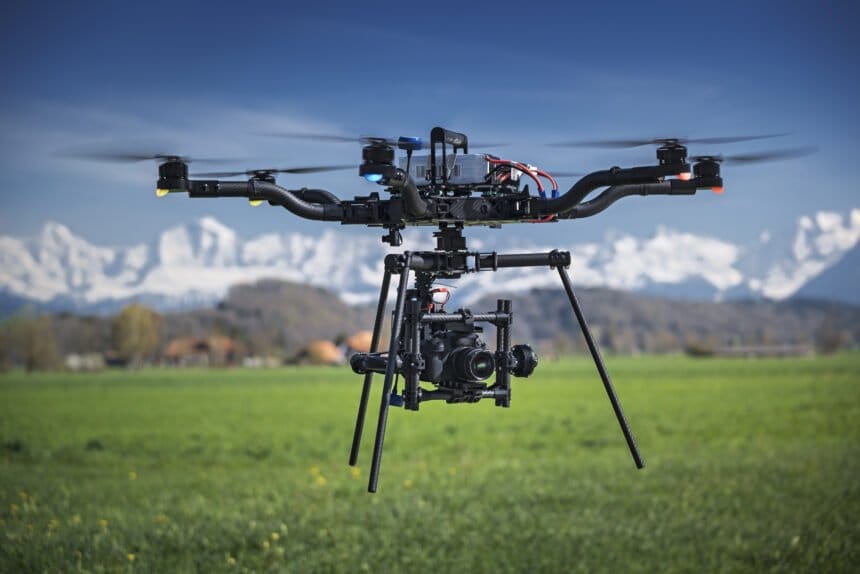Artificial intelligence (AI) rapidly transforms diverse technologies, from self-driving cars to intelligent assistants. Its ability to learn, adapt, and make decisions is revolutionizing industries. As AI’s role expands, navigating its ethical implications and ensuring responsible development will be crucial for a future shaped by this powerful technology.
Drones are some of the products that are most affected by AI. According to one analysis, the global market for AI for drone projects is likely to be worth $84 billion by 2030.
Counter drone solutions are evolving alongside AI, harnessing its power for more intelligent threat detection, response automation, and adaptive strategies. This integration promises a future where these systems become more precise, efficient, and capable of tackling increasingly complex drone threats.
We already talked about the integration of drones and big data technology. Now, let’s explore the impact of AI on drones.
AI integration in UAVs
Drones are no longer just remote-controlled machines; they’re becoming intelligent agents thanks to AI. This integration manifests in fascinating ways:
Imagine drones navigating complex routes autonomously, adapting to weather changes, and avoiding real-time obstacles. AI-powered autonomous flight lets drones perform intricate tasks without human intervention, making them ideal for search and rescue missions, infrastructure inspections, and deliveries in remote areas.
Seeing the Unseen
With AI-powered image recognition (something that you can learn more about here), drones become perceptive machines. They can accurately identify objects and people for security surveillance. Imagine a drone spotting a lost hiker hidden beneath dense foliage or pinpointing a damaged power line during inspections. – AI makes these feats possible.
Efficiency Gets an Upgrade
AI’s analytical prowess tackles operational challenges like complex flight paths and battery limitations. AI optimizes flight paths by factoring in weather, airspace restrictions, and battery life, minimizing risk and maximizing efficiency. Additionally, AI can predict potential maintenance issues, ensuring drones stay operational for longer durations.
AI Integration in Counter Drone Solutions
The fight against unauthorized drones takes flight, with AI becoming a key weapon in the Counter-Drone arsenal. AI brings intelligent detection, analysis, and even autonomous countermeasures to the skies.
AI’s eagle eye scrutinizes the skies with advanced algorithms.
Data from multiple sensors, including radar, cameras, and acoustic detectors, are fused and analyzed in real time. Machine learning algorithms trained on vast datasets can distinguish the signature of an authorized drone from a potential threat. Factors like size, flight patterns, and radio frequency emissions are considered. This allows for early detection and faster response, preventing unauthorized drones from infiltrating restricted airspace or posing security risks.
Beyond mere detection, AI’s true power lies in its dynamic response. After analyzing the threat level, it recommends the most effective countermeasure, from jamming signals to deploying capture nets or disabling flight with non-kinetic lasers. This adaptability is critical, as AI algorithms continuously learn and update their strategies to neutralize ever-evolving tactics employed by unauthorized drones.
But AI’s brilliance extends beyond the immediate. It becomes the brains behind the brawn, analyzing historical data to predict flight paths and vulnerable areas, which enables proactive countermeasure deployment. Moreover, AI can identify patterns in unauthorized activity, uncovering potential networks or malicious intent.
This intelligence gathering equips authorities with the power to take preventative measures, making AI an invaluable weapon in counter-drone solutions.
Balancing Security and Privacy in Uncertain Skies
While AI undoubtedly enhances drone security by enabling advanced detection and mitigation of unauthorized activities, its integration raises significant privacy concerns. AI-powered drones with facial recognition or other biometric sensors can collect vast amounts of personal data, potentially leading to surveillance, profiling, and discrimination. This necessitates careful consideration of its impact on existing regulatory frameworks.
Current drone regulations often struggle to keep pace with AI’s advancements. Existing frameworks typically focus on airspace restrictions, leaving significant gaps in data collection, usage, and AI-powered storage. This creates regulatory uncertainty and potential loopholes for misuse. Additionally, the ability of AI-driven drones to make autonomous decisions introduces ethical dilemmas in accountability.
Addressing these challenges requires a multi-pronged approach. Adaptive and comprehensive regulations are crucial. These regulations should address data collection, storage, usage, and access with clear guidelines for AI-powered drones. Establishing ethical frameworks regarding decision-making and accountability becomes essential.
Collaboration between stakeholders is necessary to develop responsible AI guidelines and ensure they remain relevant as technology evolves.
Conclusion
The integration of AI in drone technology is a double-edged sword. While it offers enhanced security, it also raises critical privacy concerns. Only through proactive and collaborative efforts can we harness the potential of AI-powered drones responsibly, ensuring our skies are secure without compromising individual privacy and fundamental rights.

